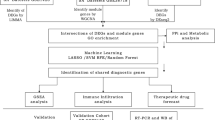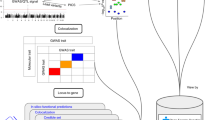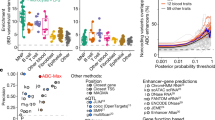Abstract
Genome-wide association studies (GWAS) have contributed significantly to the understanding of complex disease genetics. However, GWAS only report association signals and do not necessarily identify culprit genes. As most signals occur in non-coding regions of the genome, it is often challenging to assign genomic variants to the underlying causal mechanism(s). Topologically associating domains (TADs) are primarily cell-type-independent genomic regions that define interactome boundaries and can aid in the designation of limits within which an association most likely impacts gene function. We describe and validate a computational method that uses the genic content of TADs to prioritize candidate genes. Our method, called 'TAD_Pathways', performs a Gene Ontology (GO) analysis over genes that reside within TAD boundaries corresponding to GWAS signals for a given trait or disease. Applying our pipeline to the bone mineral density (BMD) GWAS catalog, we identify ‘Skeletal System Development’ (Benjamini–Hochberg adjusted P=1.02x10−5) as the top-ranked pathway. In many cases, our method implicated a gene other than the nearest gene. Our molecular experiments describe a novel example: ACP2, implicated near the canonical ‘ARHGAP1’ locus. We found ACP2 to be an important regulator of osteoblast metabolism, whereas ARHGAP1 was not supported. Our results via BMD, for example, demonstrate how basic principles of three-dimensional genome organization can define biologically informed association windows.
Similar content being viewed by others
Log in or create a free account to read this content
Gain free access to this article, as well as selected content from this journal and more on nature.com
or
References
Welter D, MacArthur J, Morales J et al: The NHGRI GWAS Catalog, a curated resource of SNP-trait associations. Nucleic Acids Res 2014; 42: D1001–D1006.
Brodie A, Azaria JR, Ofran Y : How far from the SNP may the causative genes be? Nucleic Acids Res 2016; 44: 6046–6054.
Claussnitzer M, Dankel SN, Kim K-H et al: FTO obesity variant circuitry and adipocyte browning in humans. N Engl J Med 2015; 373: 895–907.
Xia Q, Chesi A, Manduchi E et al: The type 2 diabetes presumed causal variant within TCF7L2 resides in an element that controls the expression of ACSL5. Diabetologia 2016; 59: 2360–2368.
Lieberman-Aiden E, van Berkum NL, Williams L et al: Comprehensive mapping of long-range interactions reveals folding principles of the human genome. Science 2009; 326: 289–293.
Dixon JR, Selvaraj S, Yue F et al: Topological domains in mammalian genomes identified by analysis of chromatin interactions. Nature 2012; 485: 376–380.
Ho JWK, Jung YL, Liu T et al: Comparative analysis of metazoan chromatin organization. Nature 2014; 512: 449–452.
Wang J, Duncan D, Shi Z, Zhang B : WEB-based GEne SeT AnaLysis Toolkit (WebGestalt): update 2013. Nucleic Acids Res 2013 41: W77–W83.
Ashburner M, Ball CA, Blake JA et al: Gene Ontology: tool for the unification of biology. Nat Genet 2000; 25: 25–29.
Estrada K, Styrkarsdottir U, Evangelou E et al: Genome-wide meta-analysis identifies 56 bone mineral density loci and reveals 14 loci associated with risk of fracture. Nat Genet 2012; 44: 491–501.
Suter A, Everts V, Boyde A et al: Overlapping functions of lysosomal acid phosphatase (LAP) and tartrate-resistant acid phosphatase (Acp5) revealed by doubly deficient mice. Dev Camb Engl 2001; 128: 4899–4910.
Greene CS, Troyanskaya OG : Accurate evaluation and analysis of functional genomics data and methods: Accurate evaluation and analysis of functional genomics data and methods. Ann N Y Acad Sci 2012; 1260: 95–100.
Rao SSP, Huntley MH, Durand NC et al: A 3D map of the human genome at kilobase resolution reveals principles of chromatin looping. Cell 2014; 159: 1665–1680.
Aguet F, Brown AA, Castel S et al Local Genetic Effects on Gene Expression Across 44 Human Tissues, 2016. Available at: http://biorxiv.org/lookup/doi/10.1101/074450 (last accessed 3 January 2017).
Ward LD, Kellis M : HaploReg: a resource for exploring chromatin states, conservation, and regulatory motif alterations within sets of genetically linked variants. Nucleic Acids Res 2012; 40: D930–D934.
Boudin E, Steenackers E, de Freitas F et al: A common LRP4 haplotype is associated with bone mineral density and hip geometry in men – data from the Odense Androgen Study (OAS). Bone 2013; 53: 414–420.
Blake JA, Eppig JT, Kadin JA, Richardson JE, Smith CL, Bult CJ : Mouse Genome Database (MGD)-2017: community knowledge resource for the laboratory mouse. Nucleic Acids Res 2017; 45: D723–D729.
Pers TH, Karjalainen JM, Chan Y et al: Biological interpretation of genome-wide association studies using predicted gene functions. Nat Commun 2015; 6: 5890.
Segrè AV, Consortium D, Investigators M et al: Common inherited variation in mitochondrial genes is not enriched for associations with type 2 diabetes or related glycemic traits. PLoS Genet 2010; 6: e1001058.
Greene CS, Himmelstein DS : Genetic association-guided analysis of gene networks for the study of complex traits. Circ Cardiovasc Genet 2016; 9: 179–184.
Acknowledgements
Hannah E Sexton and Troy L Mitchell assisted in optimizing siRNA transfection conditions. Daniel Himmelstein and Amy Campbell performed analytical code review. This work was supported by the Genomics and Computational Biology Graduate program at the University of Pennsylvania (to GPW); the Gordon and Betty Moore Foundation’s Data Driven Discovery Initiative (grant number GBMF 4552 to CSG); the National Institute of Dental and Craniofacial Research (NIH grant number F32DE026346 to DWY). SFAG is supported by the Daniel B Burke Endowed Chair for Diabetes Research. All data used to construct the TAD_Pathways approach are publically available data sets. All the softwares used to develop this approach are publically available in a GitHub repository (http://github.com/greenelab/tad_pathways_pipeline). We also provide a docker image (https://hub.docker.com/r/gregway/tad_pathways/) and archive the GitHub Software on Zenodo (https://zenodo.org/record/254190).
Author information
Authors and Affiliations
Corresponding author
Ethics declarations
Competing interests
The authors declare no conflict of interest.
Additional information
Supplementary Information accompanies this paper on European Journal of Human Genetics website
Supplementary information
Rights and permissions
About this article
Cite this article
Way, G., Youngstrom, D., Hankenson, K. et al. Implicating candidate genes at GWAS signals by leveraging topologically associating domains. Eur J Hum Genet 25, 1286–1289 (2017). https://doi.org/10.1038/ejhg.2017.108
Received:
Revised:
Accepted:
Published:
Issue date:
DOI: https://doi.org/10.1038/ejhg.2017.108
This article is cited by
-
Genome-wide association study implicates novel loci and reveals candidate effector genes for longitudinal pediatric bone accrual
Genome Biology (2021)
-
Effect of 6p21 region on lung function is modified by smoking: a genome-wide interaction study
Scientific Reports (2020)
-
Chromothripsis, a credible chromosomal mechanism in evolutionary process
Chromosoma (2019)
-
Maternal and fetal genetic effects on birth weight and their relevance to cardio-metabolic risk factors
Nature Genetics (2019)
-
Leveraging epigenomics and contactomics data to investigate SNP pairs in GWAS
Human Genetics (2018)



